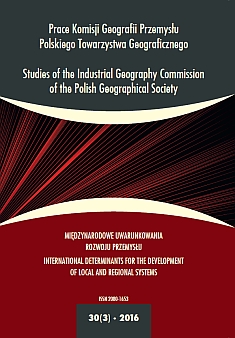Decomposition Method for Changes in the Structure
DOI:
https://doi.org/10.24917/20801653.303.2Keywords:
change decomposition, clustering structures, comparing structures, employmentAbstract
Structure can be understood in two ways. The first one means the configuration of points in amultidimensional space, and the second one is a sequence of nonnegative numbers summing to one. In thepaper the authors analyse the latter meaning of structure. It is in fact an arithmetic result of comparing partswith the whole and only then can we talk about “shape”. Values of structure elements define its “size”. Weneed at least two elements to have a nontrivial structure. A change in size does not have to cause a changein shape if changes in size are proportional for all elements. The change in shape must follow the change insize. Two measures have been proposed in the paper to reflect both types of changes while comparing twostructures. They show the share of each structure element in changes and their sign define the direction ofinfluence (positive or negative). Absolute values of each measure sum up to one. As an example, the analysisof structural employment changes in the regions of Czech Republic, between 2008 and 2014 is presented inthe paper.Downloads
Metrics
References
Chomątowski, S., Sokołowski, A. (1978). Taksonomia struktur. Przegląd Statystyczny, 2, 217–226.
Eurostat (2015, 20 października). Pozyskano z http://ec.europa.eu/eurostat/web/regions/ data/database[lfst_r_lfe2en2]
Kukuła, K. (1986). Przegląd wybranych miar zgodności struktur. Przegląd Statystyczny, 4, 384–401.
Regions in the European Union. Nomenclature of territorial unit for statistics NUTS 2010/EU-27 (2011). Luxembourg: European Commission.
Walesiak, M. (1983a). Podobieństwo wielkości (skali) oraz kształtu (formy) w złożonych badaniach strukturalnych. Wiadomości Statystyczne, 3, 26–28.
Walesiak, M. (1983b). Propozycja rodziny miar odległości struktur udziałowych. Wiadomości Statystyczne, 10, 23–24.
Downloads
Published
How to Cite
Issue
Section
License
Articles are published under the terms of the Creative Commons License (CC BY-ND 4.0; Attribution– NoDerivs).

